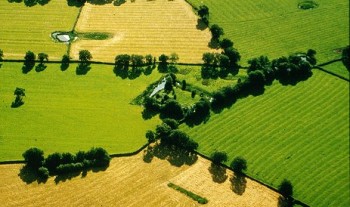
Cymraeg / English

|
Maelor Saesneg Historic Landscape |

|
Character area map |
Historic Landscape Characterisation
Maelor Saesneg:
Halghton
Bangor Is-y-coed, Hanmer, Maelor South, Overton and Willington Worthenbury communities, Wrexham County Borough
(HLCA 1120)
 Extensive area of medieval strip fields and ridge and furrow with associated moated sites, scattered farms and later small roadside settlements.
Extensive area of medieval strip fields and ridge and furrow with associated moated sites, scattered farms and later small roadside settlements.
Historic background
Early agricultural settlements of perhaps the 8th and 9th centuries is suggested by place-names Halghton, Wallington and Willington with the Old English element -tun, though there is no further historical evidence relating to these settlements before the Middle Ages. The small village at Worthenbury, whose name includes the Old English place-name element burh ('stronghold'), signifying a defensive structure of some kind. Worthenbury (Hurdingberie) is one of the few settlements in Maelor Saesneg which are specifically mentioned in the Domesday survey of 1086, and which before the Norman conquest formed a manor held by Edwin, the Saxon earl of Mercia. Tenants at Worthenbury at the time of the conquest included an unnamed knight and three unnamed Frenchmen, all of whom may have been granted lands in return for military service. Apart from Worthenbury, the area remained at some remove from early ecclesiastical centres. Even the church at Worthenbury, however, first mentioned in the later 14th century, remained a dependent chapelry within the parish of Bangor Is-y-coed until the late 17th century.Key historic landscape characteristics
Relatively flat and low-lying area, generally between 30-60 metres above Ordnance Datum and sloping to the north, dissected by a number of small wooded streams such as Emral Brook and Mill Brook which are tributaries of the Worthenbury Brook which join the River Dee at Shocklach Green.Little is known of the early settlement within the character area despite the place-name evidence for Anglo-Saxon settlements of perhaps the 8th to 10th centuries, probably focused on a number of dispersed agricultural manors, Halghton itself, for example, having neither a village nor church. A subsequent phase of settlement is represented by a distinctive group of 5-6 moated sites including those at Halghton Hall, Halghton Lodge, Holly Bush Farm, Lightwood Farm, Bryn, Peartree Lane and possibly at Mulsford Hall, which were no doubt originally associated with timber halls which have long since vanished above ground. They appear to have been the focus of a number of smaller manors, perhaps established in the wake of the Edwardian conquest of Wales in the later 13th century, and possibly represent a colonising phase of agriculture, during which extensive areas of arable land were first exploited on an intensive scale.
The fieldscapes within the character area are dominated by strip fields and reorganised strip fields of medieval origin, many of which are associated with ridge and furrow, together with other field patterns including both large and small regular fields which may have originated from the enclosure of former open fields. Little documentary evidence of the organisation of the open fields has survived , though reference was made to open field strips in Willington in the 15th century. Modern land use is predominantly grassland, fields being characteristically defined by multi-species hedges with scattered mature hedgerow oaks.
Later settlement, probably largely dating from the early post-medieval period onwards, is represented by a number of linear settlements that grew up along roadsides and near important road junctions, such as those at Holly Bush, Little Cloy and Halghton Lane.
Early halls assumed to have been associated with the moated sites were replaced chronologically and occasionally on adjacent sites by a series of 16th- to 17th-century timber-framed farmhouses such as Buck Farm, Willington Cross, The Dukes, The Fields, The Bryn, and Peartree Farm, which were generally extended in brick in the later 17th to early 19th centuries. Other farmhouses such as those Mulsford Hall and Holly Bush Farm are characteristic substantial brick-built farmhouses of the mid and later 18th century.
Sources
Aberg 1978Baughan 1991
Charles 1938
Hill 1981
Hubbard 1986
Musson 1994
Pratt 1964; 1998; 1999
Silvester et al. 1992
Spurgeon 1991
Sylvester 1969
Listed Building lists
Regional Sites and Monuments Record
For further information please contact the Clwyd-Powys Archaeological Trust at this address, or link to the Countryside Council for Wales' web site at www.ccw.gov.uk.
Privacy and cookies